Abstract
The influence of inbreeding depression on phenotypic traits of a Basset Hound dog Italian population was evaluated. Moreover, this paper reports the first results of a survey on morphological traits and analyse the genetic variability of the population using genealogical information. The following traits were studied: height at withers, height of chest, depth of chest, body length, length at rump, ischiatic width of rump, circumference of chest, circumference of cannon, length of ear, and length of nose. The inbreeding coefficient (F) of each dog was computed by genealogical data. Traits were taken from 75 adult (mean age 2.17 ± 1.545 years) dogs (36 males and 39 females) belonging to 19 different Italian farms. A linear regression of each trait on inbreeding coefficient was used to estimate inbreeding depression. ANOVA was used to test the differences in morphological traits between the sexes, among breeders and among animals with different F level. Despite the good level of genetic variability and the low coefficients of inbreeding observed in the population, a significant weakly effect of inbreeding on the depth of chest was observed. In addition, the present study revealed no significant differences in morphological traits between sexes and among farms.
Similar content being viewed by others
References
Barba Capote CJ, Herrera Garcia M, Delgado Bermejo JV, Gutiérrez Cabezaz MJ (1996) Morpho-functional differences in the spanish water dog. Arch Zootec 45:37–43
Barczak E, Wolc A, Wójtowski J, Ślósarz P, Szwaczkowski T (2009) Inbreeding and inbreeding depression on body weight in sheep. J Anim Feed Sci 18:42–50
Beretti V, Vaccari Simonini F, Soffiantini CS, Sabbioni A (2008) Morphological characteristics and growth curves of Bolognese dog breed. In: Proc. 62th SISVET congress, S. Benedetto del Tronto (AP), 24–26 Settembre 2008, pp 449–450
Brzeski KE, Rabon DRJ, Chamberlain MJ, Waits LP, Taylor SS (2014) Inbreeding and inbreeding depression in endangered red wolfes (Canis rufus). Mol Ecol 23:4241–4255
Cecchi F, Bramante A, Mazzanti E, Ciampolini R (2009) A colony of dog guides: analysis of the genetic variability assessed by pedigree data. Ital J Anim Sci 8(Suppl. 2):48–50
Cecchi F, Paci G, Spaterna A, Ciampolini R (2013) Genetic variability in Bracco Italiano dog breed assessed by pedigree data. Ital J Anim Sci 12:348–352
Cecchi F, Paci G, Spaterna A, Ciampolini R (2015) Morphological traits and inbreeding depression in Bracco Italiano dog breed. Ital J Anim Sci 14:374–377
Cecchi F, Giacalone G, Paci G (2016a) Inbreeding depression in Lizard canaries breed estimated by pedigree analysis. Czech J Anim Sci 61:15–21
Cecchi F, Paci G, Spaterna A, Ragatzu M, Ciampolini R (2016b) Demographic approach on the study of genetic parameters in the dog Braque Français type Pyrénées Italian population. Ital J Anim Sci 15:1–7
Ciampolini R, Cecchi F, Paci G, Policardo C, Spaterna A (2013) Investigation on the genetic variability of the American Pit Bull Terrier dogs belonging to an Italian breeder using microsatellite markers and genealogical data. Cytol Genet 47:217–221
Cole JB, Franke DE, Leighton EA (2004) Population structure of a colony of dog guides. J Anim Sci 82:2906–2912
Curik I, Zechner P, Sölkner J, Achmann R, Bodo I, Dovc P, Kavar T, Marti E, Brem G (2003) Inbreeding, microsatellite heterozygosity, and morphological traits in Lipizzan horses. J Hered 94:125–132
Gandini GC, Bagnato A, Miglior F, Pagnacco G (1992) Inbreeding in the Italian Haflinger horse. J Anim Breed Genet 109:433–443
Glażewska I (2008) Genetic diversity in Polish hounds estimated by pedigree analysis. Livest Sci 113:296–301
Gómez MD, Valera M, Molina A, Gutiérrez JP, Goyache F (2009) Assessment of inbreeding depression for body measurements in Spanish Purebred (Andalusian) horses. Livest Sci 122:149–155
Gonzales-Recio O, Lopez de Maturana E, Gutierrez JP (2007) Inbreeding depression on female fertility and calvin case in Spanish dairy cattle. J Dairy Sci 90:5744–5752
Hossein-Zadeh NG (2012) Inbreeding effects on body weight traits of Iranian Moghani sheep. Arch Tierz 55:171–178
Jansson M, Laikre L (2014) Recent breeding history of dog breeds in Sweden: modest rates of inbreeding, extensive loss of genetic diversity and lack of correlation between inbreeding and health. Anim Breed Genet 131:153–162
Jordana J, Manteca X, Ribo O (1999) Comparative analysis of morphological and behavioral characters in the domestic dog and their importance in the reconstruction of phylogenetic relationships in canids. Genet Mol Biol 22:49–57
Keller LF, Waller DM (2002) Inbreeding effects in wild populations. Trend Ecol Evol 17:230–241
Khan MS, Ali A, Hyder AU, Iqbal AI (2007) Effect of inbreeding on growth and reproduction traits of Beetal goats. Arch Tierz 50:197–203
Leroy G (2011) Genetic diversity, inbreeding and breeding practices in dogs: results from pedigree analyses. Vet J 189:177–182
Leroy G, Rognon X, Varlet A, Joffrin C, Verrier E (2006) Genetic variability in French dog breed assessed by pedigree data. J Anim Breed Genet 123:1–9
Malhado CHM, Malhado ACM, Carneiro PLS, Ramos AA, Carrillo JA, Pala A (2013) Inbreeding depression on production and reproduction traits of buffaloes from Brazil. Anim Sci J 84:289–295
Marr AB, Arcese P, Hochachka WM, Reid JM, Keller LF (2006) Interactive effects of environmental stress and inbreeding on reproductive traits in a wild bird population. J Anim Ecol 75:1406–1415
Martinez M, Armstrong E, Gagliardi R, Llambi S (2011) Estudio ógico del perro Cimarrón Urugayo (Pedigree analysis of the canine breed Cimarrón Uruguayo). Archiv de Zoot 60:1327–1330
Mokhtari MS, Moradi Shahrbabak M, Esmailizadeh AK, Moradi Shahrbabak H, Gutierrez JP (2014) Pedigree analysis of Iran-Black sheep and inbreeding effectson growth and reproduction traits. Small Rum Res 16:14
Nicholas FW, Crook A, Sargan DR (2011) Internet resources cataloguing inherited disorders in dogs. Vet J 189:132–135
Niknafs S, Abdi H, Fatemi SA, Zandi MB, Baneh H (2013) Genetic trend and inbreeding coefficients effects for growth and reproductive Traits in Mazandaran indigenous chicken. J Biol 3:25–31
Ólafsdóttir GA, Kristjánsson T (2008) Correlated pedigree and molecular estimates of inbreeding and their ability to detect inbreeding depression in the Icelandic sheepdog, a recently bottlenecked population of domestic dogs. Conserv Gen 9:1639–1641
Różańska-Zawieja J, Nienartowicz-Zdrojewska A, Mucha M, Sobek Z, Stanisławsk D, Gierdziewicz M, Kania-Gierdziewicz J (2013) Evaluation of inbreeding and relationship coefficients in Hovawart dogs and analysis of trends in coat colour changes. Ann Anim Sci 13:253–262
Sabbioni A, Beretti V, Vaccari Simonini F (2007) Parametri demografici, variabilità genetica e struttura della popolazione nella razza canina “Lagotto Romagnolo”. In: Proc. LXI congr. S.I.S.Vet, Salsomaggiore Terme, Italy, pp 409–410
Sabbioni A, Beretti V, Vaccari Simonini F (2008) Parametri demografici, variabilità genetica e struttura della popolazione nella razza canina Bolognese. In: Proc. LXII congr. S.I.S.Vet, San Benedetto del Tronto, Italy, pp 467–468
Sargolzaei M, Iwaisaki H, Colleau JJ (2006) CFC (Contribution, Inbreeding (F)), Coancestry, Release 1.0. A software package for pedigree analysis and monitoring genetic diversity. In: Proc. 8th world cong. on genetics applied on livestock production, Belo Horizonte, Brazil, CD-ROM comm. N 27–28
SAS, JMP (2002) User’s Guide, ver. 5.0 SAS Inst. Cary, NC, U.S.A.
Sierszchulski J, Helak M, Wolc A, Szwaczkowski T, Schlote W (2005) Inbreeding rate and its effect on some conformation traits in Arabian mares. Anim Sci Pap Rep 23:51–59
Silió L, Rodríguez MC, Fernández A, Barrangán C, Benítez R, Óvilo C, Fernández AI (2012) Measuring inbreeding and inbreeding depression on pig growth from pedigree or SNP-derived metrics. J Anim Breed Genet 130:349–360
Società Basset Hound Italiana (2011) Lo standard ufficiale di razza. (FCI Standard n° 163 del 27 gennaio 2011). http://www.canitalia.it/CLUB/bassethound/index2.htm. Accessed 31 Jan 2018
Switonski M (2014) Dog as a model in studies on human hereditary disease and their gene therapy. Reprod Biol 14:44–50
Tomezzoli A (2015) Il Basset Hound e la pet therapy. Basset Hound e dintorni. La prima rivista on line dedicata ai nostri Basset, a cura della S.i.Bas (Società Italiana Basset Hound) 3:14–16
Ubbink GJ, Knol BW, Bouw J (1992) The kinship between homozigosity and the occurrence of specific diseases in Bouvier Belge Des Flandres dogs in Netherlands. Vet Q 14:137–140
Ubbink GJ, van de Broek HAW, Hazewinkel K, Rothuizen J (1998) Risk estimates for dichotomous genetic disease traits based on a cohort study of relatedness in purebred dog populations. Vet Rec 142:209–213
Vaccari Simonini F, Beretti V, Sabbioni A (2007) Morphologic characteristics of “Lagotto Romagnolo” dog breed. In: Proc. 61th SISVET congress, Salsomaggiore Terme (PR) 26–29 September, pp 411–412
Van der Beek S, Nielen AL, Schukken YH, Brascamp EW (1999) Evaluation of genetic, common-litter, and within-litter effects on preweaning mortality in a birth cohort of puppies. Am J Res 60:1106–1110
Voges S, Distl O (2009) Inbreeding trends and pedigree analysis of Bavarian mountain hounds, Hanoverian hounds and Tyrolean hounds. J Anim Breed Genet 126:357–365
Wolc A, Balińska K (2010) Inbreeding effects on exterior traits in Polish konik horses. Arch Tierz 53:1–8
Acknowledgements
This work is supported by Grant of University of Pisa (Ateneo—Prof. Francesca Cecchi).
Author information
Authors and Affiliations
Corresponding author
Ethics declarations
Conflict of interest
The authors report that they have no conflicts of interest. The authors alone are responsible for the content and writing of this article.
Rights and permissions
About this article
Cite this article
Cecchi, F., Carlini, G., Giuliotti, L. et al. Inbreeding may affect phenotypic traits in an Italian population of Basset Hound dogs. Rend. Fis. Acc. Lincei 29, 165–170 (2018). https://doi.org/10.1007/s12210-018-0676-9
Received:
Accepted:
Published:
Issue Date:
DOI: https://doi.org/10.1007/s12210-018-0676-9




